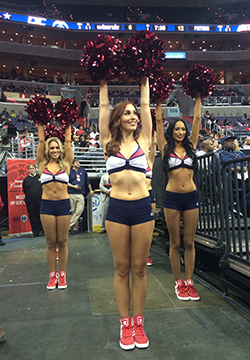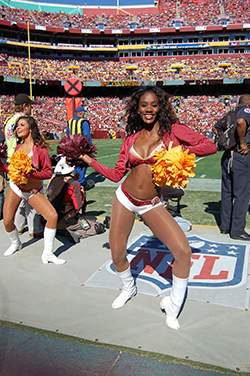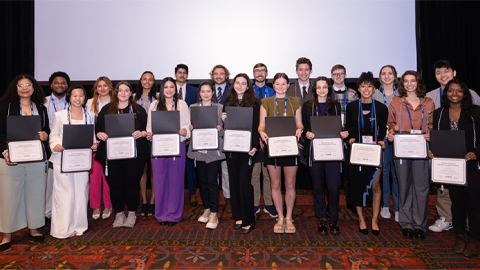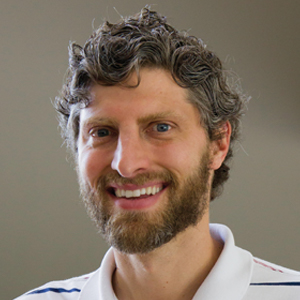The other lives of cheerleaders
Simply listening to Julia, a cheerleader for the NBA’s Washington Wizards, describe her weekly routine is exhausting. She rattles off a typical schedule for the team’s cheer squad: “Game on Monday, practice Tuesday, game on Wednesday, practice Thursday, maybe a night off, game Saturday, practice on Sunday and another game on Monday.”
 Julia leads a cheer by the Wizards Girls during a game in 2014.Image courtesy of Washington Wizards
Julia leads a cheer by the Wizards Girls during a game in 2014.Image courtesy of Washington Wizards
And, for Julia, this demanding schedule is merely half of her story. Like nearly all professional cheerleaders, she also has a full-time job on top of her duties on the sidelines. “I don’t think people realize the double lives we lead,” says Julia, who is a producer and reporter for PBS NewsHour and holds a master’s degree in environmental science.
Counting nurses, accountants and lawyers among their ranks, cheerleaders like Julia and Teleza, a cheerleader for the NFL’s Washington Redskins who teaches middle-school science and math, devote an equal amount of time and effort to cheering and their careers. (In keeping with team policy, neither woman can reveal her last name.) In doing so, they are able not only to fulfill their personal and professional dreams and ambitions but also to serve as role models for younger generations.
Simply by being who they are, women like Julia and Teleza represent a nontraditional type of advocacy that is critical, according to Darlene Cavalier, the founder of the STEM outreach organization Science Cheerleader. For better or for worse, cheerleaders have the aura of glamour and glitter, which “allows us to tap into audiences that are almost impossible to (otherwise) reach,” says Cavalier. “There’s no denying the long lines of little girls who come up to them at events who want signed autographs.”
Julia concurs: “Shiny pompoms always have a way of capturing young girls’ attention.”
Pursuing science and dance
Teleza and Julia both say that their passion for cheerleading developed when they were little girls, brought about through an interest in dancing. Teleza remembers that when she was a child, “my mother immediately threw me into dance classes.” Following a move to the Washington, D.C., area from Montreal, Canada, she trained extensively at the National Ballet Institute for the Arts and The Washington School of Ballet, and joined her high-school dance team.
Inspired by her pediatrician, Teleza also developed a strong interest in science and medicine. She was so enamored of biology in high school that she decided to major in the subject (and minor in chemistry) at Howard University with plans to attend medical school. Teleza also kept up with her dancing, joining the school’s “Showtime” Marching Band, which performs dance routines at football games.
During her senior year, encouraged by former and current Redskins cheerleaders with whom she was friends, Teleza tried out for the Redskins’ cheer squad. In her first tryout, she made the team, and she has been a cheerleader for the Redskins for three seasons.
Julia similarly was introduced to dancing at a young age. “The irony was when I was really little, I didn’t like going to ballet classes, but I wanted to be a cheerleader,” she recalls. “My mom said, ‘If you want to be a cheerleader, you have to go to ballet classes.’” So Julia did ballet throughout her childhood while also developing a burgeoning interest in science, inspired by her father, a chemical engineer at Louisiana State University.
After obtaining a degree in marine biology from Duke University, Julia went on to pursue a master’s degree in environment science management at the University of California, Santa Barbara, where she also ended up taking journalism classes. Deciding to pursue a journalism career after graduating, Julia arrived in Washington, D.C., in 2010 for an internship at PBS NewsHour. She ended up being hired on full time and has been there since.
For a few years, dancing and cheerleading had taken a back seat. But in 2011, Julia watched one of her former Duke cheerleading squad members, at that point a consultant at Accenture, successfully audition to be a cheerleader for the New York Knicks. “I started thinking that if she could balance both – a real stressful career and cheerleading – maybe that’s something I can do,” she says. Julia is now in her fourth season as a Wizards Girl and has served as one of the team captains for two years.
“Career suicide”
 Teleza has been a cheerleader with the Washington Redskins for three seasons.Image courtesy of Emily Rawdon
Teleza has been a cheerleader with the Washington Redskins for three seasons.Image courtesy of Emily Rawdon
Both Julia and Teleza say that they were nervous initially about how they would be perceived in the workplace once their cheerleading personas were uncovered. Such apprehension is to be expected, says Cavalier. She points out that a generation ago, for a female scientist or engineer to admit to cheerleading “would absolutely have been career suicide.”
However, Julia and Teleza both found that they had nothing to worry about. At first, Julia told only her boss at PBS about her cheerleading, concerned that men would behave inappropriately toward her and that women would judge her.
But as she has become more open about being a Wizards Girl, Julia has been delighted by the responses. “People are taken aback and surprised that I’m able to do almost two full-time jobs at once and that I’m talented enough to have made the team,” she says.
She notes with delight that these conversations usually bring up one question: “They wonder, ‘Oh, can I get tickets to the games?’” The answer is no.
Teleza has taken a different approach. At her first teaching job in a Virginia suburb of Washington, D.C., she was open about her cheerleading. But when she switched to a new teaching job in D.C., she kept it under wraps. Within a month of school starting, rumors were circulating. So Teleza took control.
In one of her classes, she confirmed for her students that, indeed, she was a Redskins cheerleader. “The reaction was hilarious,” she says. One student “was taking all these deep breaths and tears started coming out of his eyes,” she recalls fondly. “I asked him ‘What’s wrong?’ He was like, ‘I can’t believe you’re a Redskins cheerleader!’”
Fellow teachers also expressed surprise. “‘If you cheer, why are you here?’” Teleza recalls being asked. “I say, ‘I have to have a job too!’”
(Both Julia and Teleza make it clear that it’s very hard to survive on a cheerleading paycheck.)
A life beyond pom-poms
Teleza and Julia have used their cheerleading positions to serve as ambassadors for science and reach audiences that otherwise wouldn’t be exposed to science. “As someone who got teased here and there for her love of science growing up, I took pride in being a role model,” Julia says of her experience working with Science Cheerleader, which has more than 300 members, during the 2012 USA Science and Engineering Festival.
Likewise, Teleza has embraced her status as a role model for her students. She constantly reminds them: “You don’t have to be afraid to live outside of your box.”
Both Julia and Teleza acknowledge that their days on the sidelines are numbered because of the demanding schedule and intense physical stamina required of cheerleaders. A torn meniscus forced Julia to sit out for two months during the 2014 NBA season. “I am seeing the writing on the wall,” she says.
Once her cheerleading days are over, Julia hopes to have her own show on television to bring science to the masses. “I would love to see more focus on actual science and try to find ways that actually hold people’s attention other than (the Discovery Channel’s) Shark Week,” she says.Teleza also sees the end as near. She is taking more science classes, preparing for the MCAT, and putting together her applications. “I know once I am in medical school, I will not be able to do this,” she says.
Until the day comes when they have to hang up their pom-poms, Julia and Teleza say they will continue to pursue their passions with equal vigor, because science and cheerleading are integral to their identities. As Teleza puts it, “This is who I am, and this is what I want to do.”
Enjoy reading ASBMB Today?
Become a member to receive the print edition monthly and the digital edition weekly.
Learn moreGet the latest from ASBMB Today
Enter your email address, and we’ll send you a weekly email with recent articles, interviews and more.
Latest in People
People highlights or most popular articles

ASBMB inducts new honor society members
Chi Omega Lambda, which recognizes exceptional juniors and seniors pursuing degrees in the molecular life sciences, has 31 inductees in 2024.

2024 voter guide
Learn about the candidates running for ASBMB Council, Nominating Committee, Publications Committee and treasurer.

Charles O. Rock (1949 – 2023)
Colleagues and trainees remember a world expert in membrane lipid homeostasis.

Honors for Clemons, Hatzios and Wiemer
Awards, honors, milestones and more. Find out what's happening in the lives of ASBMB members.

Touching the future from the bench
Scholar, scientist, teacher and mentor Odutayo Odunuga discusses the important roles of the institutional PI, his journey and his research.

In memoriam: Darwin Prockop
He held leadership positions at multiple institutions and was known for his contributions to adult stem cell biology and cellular biology.


